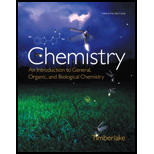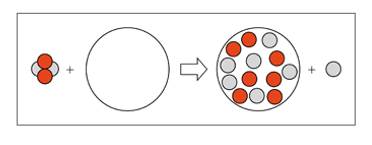
Chemistry: An Introduction to General, Organic, and Biological Chemistry (12th Edition) - Standalone book
12th Edition
ISBN: 9780321908445
Author: Karen C. Timberlake
Publisher: PEARSON
expand_more
expand_more
format_list_bulleted
Concept explainers
Textbook Question
Chapter 5, Problem 5.47UTC

5.53 Draw the nucleus of the isotope that is bombarded in the following: (5.2)

Expert Solution & Answer
Trending nowThis is a popular solution!

Students have asked these similar questions
Part VII. Below are the 'HNMR, 13 C-NMR, COSY 2D- NMR, and HSQC 2D-NMR (similar with HETCOR but axes are reversed) spectra of an
organic compound with molecular formula C6H1003 - Assign chemical shift values to the H and c atoms of the
compound. Find the structure. Show complete solutions.
Predicted 1H NMR Spectrum
4.7 4.6 4.5 4.4 4.3 4.2 4.1 4.0 3.9 3.8 3.7 3.6 3.5 3.4 3.3 3.2 3.1 3.0 2.9 2.8 2.7 2.6 2.5 2.4 2.3 2.2 2.1 2.0 1.9 1.8 1.7 1.6 1.5 1.4 1.3 1.2 1.1
f1 (ppm)
Predicted 13C NMR Spectrum
100
f1 (ppm)
30
220 210 200 190 180
170
160 150 140 130 120
110
90
80
70
-26
60
50
40
46
30
20
115
10
1.0 0.9 0.8
0
-10
Q: Arrange BCC and Fec
metals, in sequence from the
Fable (Dr. R's slides) and
Calculate Volume and Density.
Aa
BCC
V
52 5
SFCC
None
Chapter 5 Solutions
Chemistry: An Introduction to General, Organic, and Biological Chemistry (12th Edition) - Standalone book
Ch. 5.1 - Prob. 5.1QAPCh. 5.1 - Prob. 5.2QAPCh. 5.1 - Naturally occurring potassium consists of three...Ch. 5.1 - Naturally occurring iodine is iodine-127....Ch. 5.1 - Prob. 5.5QAPCh. 5.1 - Prob. 5.6QAPCh. 5.1 - Prob. 5.7QAPCh. 5.1 - Prob. 5.8QAPCh. 5.1 - Identify each of the following: a. 10X b. 24X c....Ch. 5.1 - Identify each of the following: a. 11X b. 3581X c....
Ch. 5.1 - Prob. 5.11QAPCh. 5.1 - Prob. 5.12QAPCh. 5.2 - Prob. 5.13QAPCh. 5.2 - Prob. 5.14QAPCh. 5.2 - Prob. 5.15QAPCh. 5.2 - Prob. 5.16QAPCh. 5.2 - Prob. 5.17QAPCh. 5.2 - Prob. 5.18QAPCh. 5.2 - Prob. 5.19QAPCh. 5.2 - Prob. 5.20QAPCh. 5.2 - Complete each of the following reactions: a....Ch. 5.2 - Prob. 5.22QAPCh. 5.3 - Prob. 5.23QAPCh. 5.3 - Prob. 5.24QAPCh. 5.3 - Prob. 5.25QAPCh. 5.3 - Prob. 5.26QAPCh. 5.3 - Prob. 5.27QAPCh. 5.3 - Prob. 5.28QAPCh. 5.4 - Prob. 5.29QAPCh. 5.4 - Prob. 5.30QAPCh. 5.4 - Prob. 5.31QAPCh. 5.4 - Prob. 5.32QAPCh. 5.4 - Prob. 5.33QAPCh. 5.4 - Prob. 5.34QAPCh. 5.5 - Prob. 5.35QAPCh. 5.5 - Prob. 5.36QAPCh. 5.5 - Prob. 5.37QAPCh. 5.5 - Prob. 5.38QAPCh. 5.6 - Prob. 5.39QAPCh. 5.6 - Prob. 5.40QAPCh. 5.6 - Prob. 5.41QAPCh. 5.6 - Prob. 5.42QAPCh. 5.6 - Prob. 5.43QAPCh. 5.6 - Prob. 5.44QAPCh. 5 - Prob. 5.45UTCCh. 5 - Prob. 5.46UTCCh. 5 - 5.53 Draw the nucleus of the isotope that is...Ch. 5 - Prob. 5.48UTCCh. 5 - Prob. 5.49UTCCh. 5 - Prob. 5.50UTCCh. 5 - Determine the number of protons and number of...Ch. 5 - Determine the number of protons and number of...Ch. 5 - Prob. 5.53AQAPCh. 5 - Prob. 5.54AQAPCh. 5 - Prob. 5.55AQAPCh. 5 - Prob. 5.56AQAPCh. 5 - Prob. 5.57AQAPCh. 5 - Prob. 5.58AQAPCh. 5 - Prob. 5.59AQAPCh. 5 - Prob. 5.60AQAPCh. 5 - Prob. 5.61AQAPCh. 5 - Prob. 5.62AQAPCh. 5 - Prob. 5.63AQAPCh. 5 - Prob. 5.64AQAPCh. 5 - Prob. 5.65AQAPCh. 5 - Prob. 5.66AQAPCh. 5 - Prob. 5.67AQAPCh. 5 - Prob. 5.68AQAPCh. 5 - Prob. 5.69AQAPCh. 5 - Prob. 5.70AQAPCh. 5 - Where does fusion occur naturally? (5.6)Ch. 5 - Prob. 5.72AQAPCh. 5 - Prob. 5.73CQCh. 5 - Prob. 5.74CQCh. 5 - Prob. 5.75CQCh. 5 - Prob. 5.76CQCh. 5 - Prob. 5.77CQCh. 5 - Prob. 5.78CQCh. 5 - Prob. 5.79CQCh. 5 - Prob. 5.80CQCh. 5 - Prob. 5.81CQCh. 5 - Prob. 5.82CQCh. 5 - Prob. 5.83CQCh. 5 - Prob. 5.84CQ
Knowledge Booster
Learn more about
Need a deep-dive on the concept behind this application? Look no further. Learn more about this topic, chemistry and related others by exploring similar questions and additional content below.Similar questions
- The emission data in cps displayed in Table 1 is reported to two decimal places by the chemist. However, the instrument output is shown in Table 2. Table 2. Iron emission from ICP-AES Sample Blank Standard Emission, cps 579.503252562 9308340.13122 Unknown Sample 343.232365741 Did the chemist make the correct choice in how they choose to display the data up in Table 1? Choose the best explanation from the choices below. No. Since the instrument calculates 12 digits for all values, they should all be kept and not truncated. Doing so would eliminate significant information. No. Since the instrument calculates 5 decimal places for the standard, all of the values should be limited to the same number. The other decimal places are not significant for the blank and unknown sample. Yes. The way Saman made the standards was limited by the 250-mL volumetric flask. This glassware can report values to 2 decimal places, and this establishes our number of significant figures. Yes. Instrumental data…arrow_forwardSteps and explanation pleasearrow_forwardSteps and explanation to undertand concepts.arrow_forward
- Nonearrow_forward7. Draw a curved arrow mechanism for the following reaction. HO cat. HCI OH in dioxane with 4A molecular sievesarrow_forwardTry: Convert the given 3D perspective structure to Newman projection about C2 - C3 bond (C2 carbon in the front). Also, show Newman projection of other possible staggered conformers and circle the most stable conformation. Use the template shown. F H3C Br Harrow_forward
- Nonearrow_forward16. Consider the probability distribution p(x) = ax", 0 ≤ x ≤ 1 for a positive integer n. A. Derive an expression for the constant a, to normalize p(x). B. Compute the average (x) as a function of n. C. Compute σ2 = (x²) - (x)², the variance of x, as a function of n.arrow_forward451. Use the diffusion model from lecture that showed the likelihood of mixing occurring in a lattice model with eight lattice sites: Case Left Right A B C Permeable Barrier → and show that with 2V lattice sites on each side of the permeable barrier and a total of 2V white particles and 2V black particles, that perfect de-mixing (all one color on each side of the barrier) becomes increasingly unlikely as V increases.arrow_forward
arrow_back_ios
SEE MORE QUESTIONS
arrow_forward_ios
Recommended textbooks for you
 Introduction to General, Organic and BiochemistryChemistryISBN:9781285869759Author:Frederick A. Bettelheim, William H. Brown, Mary K. Campbell, Shawn O. Farrell, Omar TorresPublisher:Cengage Learning
Introduction to General, Organic and BiochemistryChemistryISBN:9781285869759Author:Frederick A. Bettelheim, William H. Brown, Mary K. Campbell, Shawn O. Farrell, Omar TorresPublisher:Cengage Learning Organic Chemistry: A Guided InquiryChemistryISBN:9780618974122Author:Andrei StraumanisPublisher:Cengage LearningChemistry: Matter and ChangeChemistryISBN:9780078746376Author:Dinah Zike, Laurel Dingrando, Nicholas Hainen, Cheryl WistromPublisher:Glencoe/McGraw-Hill School Pub Co
Organic Chemistry: A Guided InquiryChemistryISBN:9780618974122Author:Andrei StraumanisPublisher:Cengage LearningChemistry: Matter and ChangeChemistryISBN:9780078746376Author:Dinah Zike, Laurel Dingrando, Nicholas Hainen, Cheryl WistromPublisher:Glencoe/McGraw-Hill School Pub Co

Introduction to General, Organic and Biochemistry
Chemistry
ISBN:9781285869759
Author:Frederick A. Bettelheim, William H. Brown, Mary K. Campbell, Shawn O. Farrell, Omar Torres
Publisher:Cengage Learning

Organic Chemistry: A Guided Inquiry
Chemistry
ISBN:9780618974122
Author:Andrei Straumanis
Publisher:Cengage Learning

Chemistry: Matter and Change
Chemistry
ISBN:9780078746376
Author:Dinah Zike, Laurel Dingrando, Nicholas Hainen, Cheryl Wistrom
Publisher:Glencoe/McGraw-Hill School Pub Co
Atomic Number, Atomic Mass, and the Atomic Structure | How to Pass ChemistryThe Nucleus: Crash Course Chemistry #1; Author: Crash Course;https://www.youtube.com/watch?v=FSyAehMdpyI;License: Standard YouTube License, CC-BY